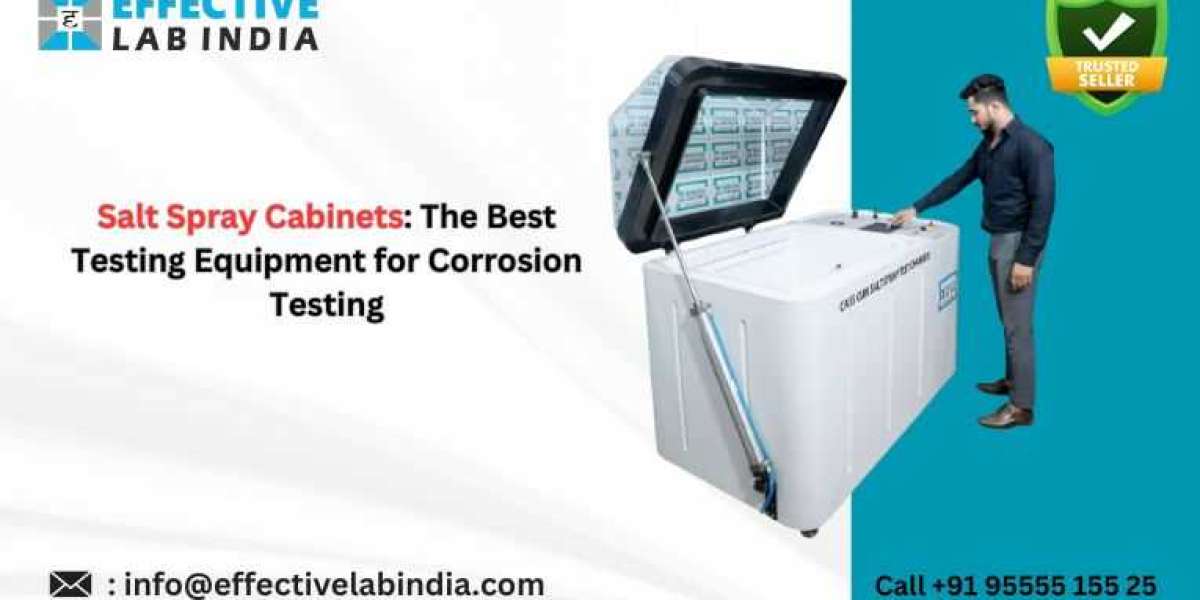Natural processes like corrosion may cause damage to metals and other materials, eventually resulting in their destruction. This is particularly challenging for sectors like construction, aircraft, and automotive where material integrity is essential. Corrosion testing is necessary for the prevention of material quality failures. Salt spray testing is a dependable and common approach among the many accessible procedures. Salt spray cabinets, specialised equipment made to mimic corrosive conditions and evaluate material durability, and are the basis of this testing methodology.
Understanding Corrosion Testing
Materials are exposed to environments that speed up the corrosion process as part of corrosion testing. This makes it possible for researchers and technology professionals to assess the performance of various materials and coatings in harsh environments. The outcomes of these tests are essential for choosing materials that can resist particular circumstances, increasing product longevity and lowering maintenance costs.
Importance of Corrosion Testing in Industry
Materials that can withstand corrosion are essential to several industries, including aerospace, automotive, marine, and construction. Predicting a material's behaviour under adverse conditions over time helps businesses guarantee cost-effectiveness, safety, and dependability. These industries can prevent unanticipated failures that might result in expensive repairs, safety risks, or even fatalities by performing corrosion testing.
Overview of Salt Spray Cabinets
Materials are exposed to a salty mist in controlled environments known as salt spray cabinets, salt fog, or salt spray chambers. The purpose of this mist is to mimic the corrosive conditions present in maritime regions and locations with elevated amounts of salt contamination. Manufacturers have the capability to assess the overall durability and efficacy of protective coatings by putting products within these cabinets.
How Do Salt Spray Cabinets Work?
For the reason to create a fine mist, salt spray cabinets work by atomising a saltwater solution, usually sodium chloride. The test samples within the cabinet are then constantly sprayed with this mist. Testing conditions may be made uniform and reproducible by carefully regulating the salt solution's temperature, humidity, and concentration. Several hours to several weeks may pass throughout the exposure period, contingent upon the test's specifications.
Key Applications of Salt Spray Cabinets
Salt spray cabinets are widely used in various industries for testing:
Automotive Components: Ensuring that car parts, especially those exposed to the elements, can withstand long-term exposure to corrosive conditions.
Coatings: Evaluating the effectiveness of paints, galvanizing, and other protective coatings.
Metal Alloys: Testing the durability of different metal compositions under corrosive stress.
Marine Equipment: Assessing the resistance of materials used in boats, ships, and offshore platforms.
Features of the Best Salt Spray Cabinets
- Fiber Reinforced Non Rusted Body
- Pneumatic Door Opening
- Digital Microprocessor-Based PID Control Panel
- Temperature Range - 35°C/48°C
- Fog Collection Out-Side
- Humidifier Air Saturator in Build
- CASS NSS Both Tests can be performed
- Air Purging System (Manual)
- Transparent canopy
Technical Specifications of Salt Spray Chamber
- Models: Salt Spray Chamber(HMI)
- Capacity: 250 Liters, 450 Liters, 1000 Liters
- Inner Dimensions (mm): 780X620X720(250LTR), 950x700x720(450LTR), 1500x960x710(1000LTR)
- Outer Dimensions (mm): 1540x1070x1300(250LTR), 1800x1250x1250(450LTR), 2370x1400x1350(1000LTR)
- Display: HMI Based touchscreen 7-inch
- Chamber Temp Range: Ambient to 40∘C
- Temperature Range of the Test Chamber: 35∘C ± 2∘C
- Minimum Temperature in the Chamber: 0.1∘C
- Repeatability of Chamber Temperature: ± 2∘C
- Temperature Range for Air Saturator: 40∘C - 49∘C
- Lowest Count for Air Saturator Temperature: 0.1∘C
- Repeatability of Air Saturator Temperature: ± 2∘C
- Power: 220V, Single phase, 50 Hz, 15 A
- pH Value of Salt Solutions: 6.5 to 7.2 pH
- Temperature Control: Inbuilt PID Temperature Controller
- Timer (Hour meter): 6 digits
- Test Air Pressure: 0.7Kg/cm2 - 1.2Kg/cm2
- Air Regulator: 0 to 30 psi
- Air Saturator water Level low alarm: Yes
- Fog Collection Funnel: 1
- Door Opening: Hydraulic
- Air Saturator Auto Refilling: Yes
- Material: Fibre Glass
- Over Temperature Alarm: Yes
- Reservoir float valve: Yes
Why Choose Effective Lab India Salt Spray Chamber
Selecting the Effective Lab India Salt Spray Chamber guarantees accurate and dependable corrosion testing. This chamber is widely recognised for its strong build and advanced control features, and it is intended to provide reliable, precise results with a range of materials. Effective Lab India distinguishes itself as a reliable option for sectors that require top-notch corrosion testing solutions with its user-friendly interfaces, adaptable testing settings, and robust post-purchase assistance. Their chambers are a fantastic long-term investment due to their remarkable performance and longevity, whether used for research or quality assurance.
Benefits of Using Salt Spray Cabinets in Corrosion Testing
There are several benefits to using salt spray cabinets for corrosion testing.
Precise Reproduction of Actual Circumstances
Accurate and trustworthy test results may be obtained by simulating the severe environments that materials would encounter in the real world in these cabinets.
Consistency in Test Results
You may attain consistent and reproducible findings by managing the cabinet's environment, which is crucial for quality assurance and comparative research.
Flexibility in Assessing Different Materials
Salt spray cabinets are an adaptable instrument in any laboratory since they may be used to test a broad variety of materials, including coatings and metals.
Comparing Salt Spray Cabinets with Other Corrosion Testing Methods
When selecting a corrosion testing method, it’s essential to understand how salt spray cabinets compare to other options:
Electrochemical Testing
Electrochemical techniques yield data quickly and with great accuracy, which makes them perfect for in-depth research. Nevertheless, they may be costly and need certain tools.
Humidity Chambers
Another important component of corrosion is excessive humidity, which may be tested for in materials using humidity chambers. They are helpful, but they don't expose users to salt directly like salt spray cabinets do.
Field Exposure Tests
For the most accurate findings, materials are subjected to real-world settings during field testing. They can be less regulated and take a lot of time, which can provide inconsistent outcomes.
Conclusion
In the battle against corrosion, salt spray test chamber is an essential instrument because it's offer a dependable way to evaluate the robustness and efficiency of materials and coatings. Having the correct salt spray cabinet may help you assure the lifespan and safety of your items, depending on whether you are in the construction, automotive, aerospace, or maritime industries. You can get the most out of corrosion testing and make responsible decisions about materials and product development via choosing equipment that suits your needs and implementing best practices.








